Content [show]
 In the summer cottages of gardeners in the middle lane, unpretentious frost-resistant varieties are often found. These include, for example, "Lydia" or "Isabella". But, unfortunately, they differ in small berries and inexpressive taste. Thanks to the efforts of breeders, species have appeared that give large berries in the harsh climatic conditions of Russia.
In the summer cottages of gardeners in the middle lane, unpretentious frost-resistant varieties are often found. These include, for example, "Lydia" or "Isabella". But, unfortunately, they differ in small berries and inexpressive taste. Thanks to the efforts of breeders, species have appeared that give large berries in the harsh climatic conditions of Russia.
Having bought varietal specimens of modern selection, one can hope for a good harvest, resistance to disease and frost. By the way, the rich taste of a large beautiful bunch will not yield to overseas products. Growing grapes in the middle lane for beginners is recommended to start with early varieties. They ripen in mid-August.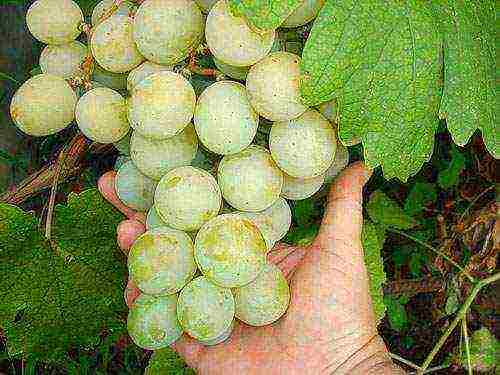
| White to pink | Deep lilac to violet |
| Amber Samara | Agat Donskoy |
| Muscat Tsikhmistrenko, dessert nutmeg | Kishmish unique |
| Delight | Brother of Rapture |
| Northern early | Early purple |
 Such varieties are considered no less popular: Kesha, Arcadia, Muromets and Cosmos. All of them are distinguished by large, fleshy berries, the size of a small plum. They have a delicate aroma, sweetness and great taste.
Such varieties are considered no less popular: Kesha, Arcadia, Muromets and Cosmos. All of them are distinguished by large, fleshy berries, the size of a small plum. They have a delicate aroma, sweetness and great taste.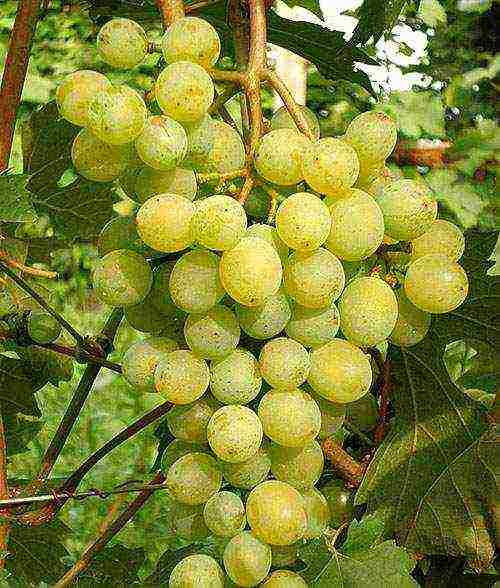
When should you buy planting material?
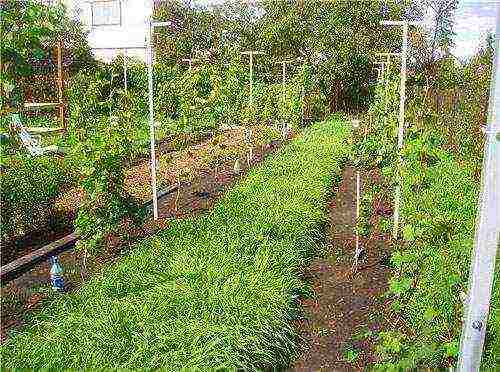 To purchase quality vines, take advantage of the advice of experienced winegrowers.
To purchase quality vines, take advantage of the advice of experienced winegrowers.
- Don't rush to buy. If you decide to buy a seedling in the nursery, do not take the first one that comes across. Assess the situation, compare types, prices. It will be good if there is an opportunity to inspect adult specimens during fruiting.
- Consider purchasing cuttings from a large vineyard. Agree with the owner about the excursion, ask about the variety of varieties. Try the bunch you like. And then ask to sell the cuttings from the selected grapes. So you are guaranteed to get the right variety, and in addition to it, valuable advice and parting words.
- Autumn material is usually more hardy than spring material. If he tolerates the winter cold, then in the spring he quickly grows.
- It is not recommended for beginners to immediately take on complex and expensive hybrid specimens. They often require increased attention, a certain knowledge base and experience.
- Purchased seedlings should not be stored. They are recommended to be soaked in clean water and planted in the soil a day later.
Do not take varieties of "elite" grapes on the market from obsessive sellers. Otherwise, you risk buying a "pig in a poke".
Where is the best place to plant?
 If you plan to plant one bush, try to find a sunny spot for it. It should be away from trees and bushes. For the future large vineyard, a place with the following characteristics is selected:
If you plan to plant one bush, try to find a sunny spot for it. It should be away from trees and bushes. For the future large vineyard, a place with the following characteristics is selected:
- slope from the south, south-west or east side;
- well lit space during the day;
- a place far from groundwater and marshy surfaces.
Do not plant the vine on the north side, under a tree, or near a body of water.
How to plant?

- The material purchased and soaked during the day is slightly trimmed. The roots are shortened quite a bit, but the shoot is reduced by 3 buds. If there are side layers, they are also removed.
- The prepared seedling is dipped with roots in a clay solution, and placed in a prepared trench or pit.
- Consult with experts on how to feed the grapes during planting, at what depth to place the heel of the shank and what drainage is best for your area. Such advice would be better than general advice.
- If planting is carried out in winter, then a mound should be made around the sprout, and when cold weather comes, cover it with a plastic bottle. From above, the shelter can be covered with mulch or peat.
- Spring planting involves moistening the planting pit. Having planted the shanks and compacting the soil around them, they make shading. The bright spring sun can burn young shoots.
- A week later, the spring seedlings are watered again, and after the soil dries out, its top layer is loosened.
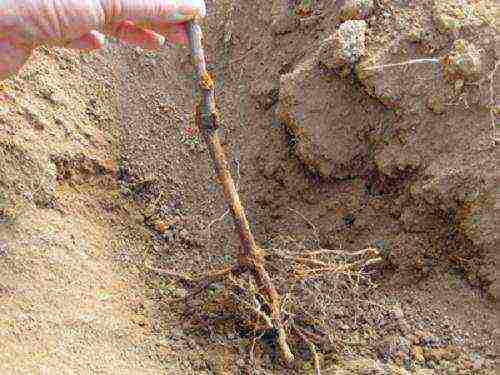
How to care for a vineyard in spring?
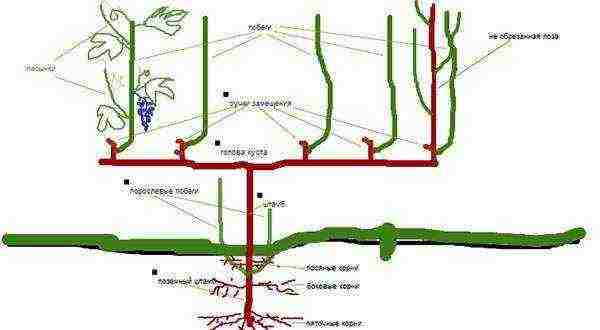 After the start of growth of young specimens, as well as one-year-old and two-year-old seedlings, a number of mandatory procedures are required. Spring grape care is as follows:
After the start of growth of young specimens, as well as one-year-old and two-year-old seedlings, a number of mandatory procedures are required. Spring grape care is as follows:
- removing weeds under the vine and around the bush;
- loosening the topsoil;
- annual pruning of weak roots at a depth of 20 cm underground (the soil is raked off and pruned);
- spring preventive spraying of plants with Bordeaux liquid before the beginning of the growing season.
How to water properly?
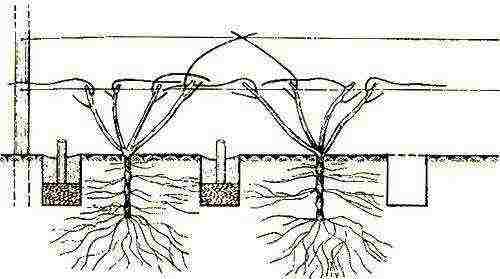 To ensure sufficient nutrition for adult plants, you need to water abundantly several times during the spring and summer season. At a time - at least 15 liters of water under 1 bush. The water in the roots must not stagnate. Otherwise, fungal diseases and decay of the root system are possible. Properly organized drainage will help to avoid this. To understand how often to water grapes in summer, you need to know the temperature regime of the region in summer. In a cold and rainy summer, you can fill the bushes 2 times. If the temperature readings are normal, then you can spend 4 watering season.
To ensure sufficient nutrition for adult plants, you need to water abundantly several times during the spring and summer season. At a time - at least 15 liters of water under 1 bush. The water in the roots must not stagnate. Otherwise, fungal diseases and decay of the root system are possible. Properly organized drainage will help to avoid this. To understand how often to water grapes in summer, you need to know the temperature regime of the region in summer. In a cold and rainy summer, you can fill the bushes 2 times. If the temperature readings are normal, then you can spend 4 watering season.
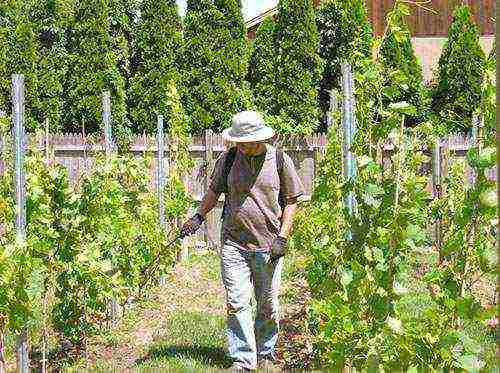 If the weather is too humid, then the grapes should be given special attention. Special treatment of grapes after rain is required. High humidity provokes the immediate spread of harmful spores. It is necessary to spray the bushes with multipurpose solutions that can protect against late blight, mildew and powdery mildew.
If the weather is too humid, then the grapes should be given special attention. Special treatment of grapes after rain is required. High humidity provokes the immediate spread of harmful spores. It is necessary to spray the bushes with multipurpose solutions that can protect against late blight, mildew and powdery mildew.
What is pruning and when to do it?
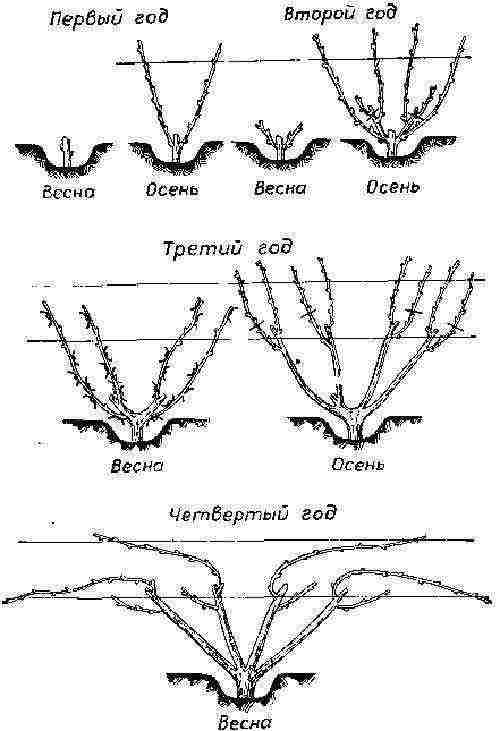 Middle lane growers perform global pruning twice a year. Pruning grapes in the fall is necessary before sheltering for the winter. Long shoots are shortened, after which it is convenient to lay them in a depression and cover. The spring procedure takes place after opening. Frozen and dry shoots are removed. In addition, during the growth of the bush, the shoots are pinched and pruned for the correct formation of the vine.
Middle lane growers perform global pruning twice a year. Pruning grapes in the fall is necessary before sheltering for the winter. Long shoots are shortened, after which it is convenient to lay them in a depression and cover. The spring procedure takes place after opening. Frozen and dry shoots are removed. In addition, during the growth of the bush, the shoots are pinched and pruned for the correct formation of the vine.
In order for the bush to be properly formed, it must be pruned from the first year. Green shoots break off, preventing them from braiding branches. On young specimens, flowering branches are removed, preventing the berries from developing. First years can be exhausted, giving all their strength to growing a bunch. The shoots left behind are guided and tied up.
If you expect to get a powerful plant, then it is better to direct all the shoots left up.
The correct formation of a grape bush from the first year is shown in a video that will help you understand the basic principles of the procedure and prevent mistakes.
How to shelter grapes for the winter?
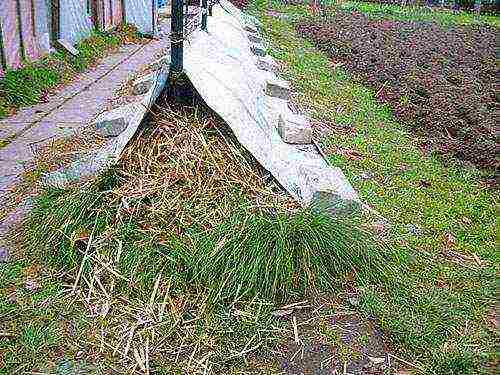 All hybrid varieties need warm wintering. Therefore, in the fall, before the onset of frost, it is necessary to dig in all the shoots or cover them with a covering material. This will keep the plant from freezing. After the autumn pruning, the bush is well watered. Then all the lashes are removed from the trellises and placed on straw or dry leaves.From above, they are covered with spruce branches, a wooden structure, or simply covered with a layer of earth.
All hybrid varieties need warm wintering. Therefore, in the fall, before the onset of frost, it is necessary to dig in all the shoots or cover them with a covering material. This will keep the plant from freezing. After the autumn pruning, the bush is well watered. Then all the lashes are removed from the trellises and placed on straw or dry leaves.From above, they are covered with spruce branches, a wooden structure, or simply covered with a layer of earth.
If you don't know how to cover your grapes for the winter, it's worth watching the video and getting ready in advance. You cannot refuse to carry out this procedure, otherwise it will not be possible to grow a healthy plant.
Formation of a young bush of grapes - video
Grape is a thermophilic plant, it feels good in the southern regions. Growing grapes in the middle lane is now quite possible. People have tried to grow grapes in more northern regions since the time of Peter. Michurin was the first to obtain varieties that are resistant to cold climates. He bred the first two early and winter-hardy varieties Amursky and Baitur. These varieties are still popular with gardeners. In the Moscow region, they winter even without shelter.
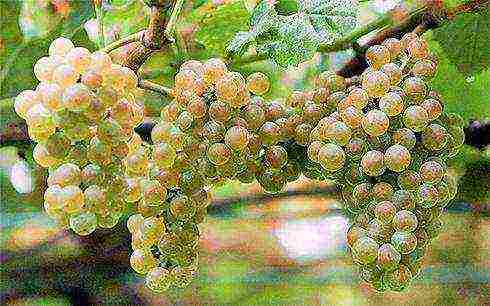
Growing grapes. Step-by-step instruction
For the successful cultivation of grapes, you must:
- Select the desired variety.
- Decide on the landing site.
- Prepare the soil for planting.
- Build supports for the seedlings.
- Plant seedlings.
- In the hot summer, watering is necessary.
- The grapes need pruning.
- Shelter for the winter.
The cultivation of grapes in the middle lane has recently become more and more interesting for summer residents and gardeners. This is quite possible, you just need to choose a suitable early ripening variety. Basically, caring for grapes in the middle lane is reduced to proper pruning, the introduction of organic and mineral fertilizers, and removing from the trellises and preparing the vine for winter is a matter of technology.
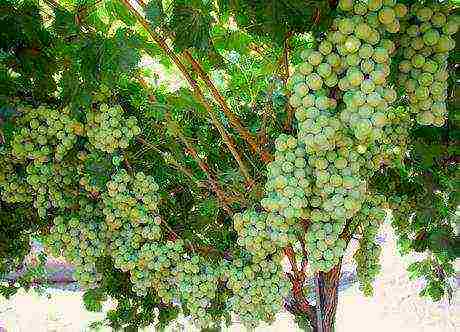
Choosing a place for grapes
A good choice of a place for grapes is already half of the success. This plant grows well in places open to sunlight and well protected from the wind. In areas with harsh climates, grapes are successfully grown against a fence or wall of a house facing southwest or south. Places with stagnant cold air are not suitable for this plant.
The soil for this southern plant should be well-drained, and the reaction should be close to neutral (pH 6.5-7.0). The location of the future vineyard has been selected, now let's start preparing the soil.
Soil preparation
Successful cultivation of grapes in the middle lane begins with the preparation of the soil. These activities should be carried out 15-20 days before planting young seedlings. In order to reduce the acidity of the soil, lime is introduced at the rate of 150-200 grams per 1 sq. m. landing area.
The soil on the site of the future vineyard must be dug deeply. Poor soil is flavored with rotted manure or compost. To do this, add one bucket of organic matter per 1 sq. m and be sure to add one of the complex mineral fertilizers, for example, superphosphate.

Support for grapes
On the site of the future vineyard, you need to build a support for the vine. In the landing row, after 2.5 meters, it is necessary to drive in wooden poles 3 meters long. They are driven into the ground to a depth of 60 cm. A metal wire is stretched between the posts. The first is located at a height of 40 cm, then the distance between the wires is 30 cm. In the future, the vine will be fixed on them.
Planting seedlings
Some subtleties of growing grapes in the middle lane still exist. First you need to choose a suitable early maturing variety. If in the southern regions grapes can be planted from October to March, then for areas with a colder climate (middle zone) the most suitable time for planting is early spring, before the leaves bloom (early May).
If planting is carried out along a fence or wall, then the distance from it to the seedling should be at least 40 cm, and in a row between plants, the gap must be maintained at 1.2 m.In case of planting in an open place, the distance in a row is 1.5 m, between grapes rows - 2 m.
If the plants are grafted, then the grafting site during planting should be above ground level.After the grapes are planted, it must be tied to a prepared support, water abundantly and mulch the soil with humus or manure, so the moisture will remain in the soil longer.
Another technique for planting grapes is planting grapes on beds, the height of which is about 25 cm. The edges of the beds are reinforced with plastic bottles dug with their neck into the ground. This method of planting allows more heat to flow to the roots and thereby accelerate the ripening period of the crop.
Pruning
The task of pruning vines is to form a powerful fruiting bush. Annual shoots are cut off. The thinner the vine, the less buds are left on it. So, for example, on a shoot with a diameter of 10 mm during autumn pruning, a maximum of 10-11 buds can be left, and only 5 buds are left on a shoot with a diameter of 5 mm.
In the spring, fruiting shoots of the current year will develop from them. In order for the cultivation of grapes in the middle lane to be successful, it is better to prune it in two steps. The first pruning is carried out in the fall after fruiting, it consists in the removal of immature vines and too thin and damaged shoots. The second stage of grape pruning is carried out in early spring, after the winter covering material has been removed. Here, damaged and frozen shoots are also removed and a decision on the load is made, in accordance with this, pruning is carried out.
Shelter for the winter
In late autumn, before the first frost, the vine is removed from the trellis, pruned, the remnants of the leaves are removed, carefully tied and laid on the ground. The base of the bush must be highlighted. If there is a graft, then hilling must be done in such a way that it is completely hidden by the ground.
Further, before the onset of stable frosts, the vine is covered. The easiest way is to cover with spruce branches. Varieties specially bred for the middle lane, covered in this way, winter well.

Another method widely practiced by gardeners is the use of non-woven covering material, such as sugril. It is wrapped around grape bushes tied and laid on the ground, and covered with roofing material on top.
In the spring, when the snow melts, these shelters are removed and the grape bushes are sanitized. Excess weak shoots, frostbitten and broken vine are cut out.
Agrotechnology of grapes: growing grapes in the middle lane
Grapes are now grown in almost every region. Let's repeat all about grapes in central Russia once again. Agrotechnology for growing grapes in this area boils down to a good choice of a place for grapes, proper planting and vine care. The place should be the sunniest in this area, in addition, cold north winds should not penetrate there; for this, a screen is installed or grapes are planted along the southern wall of the house or fence.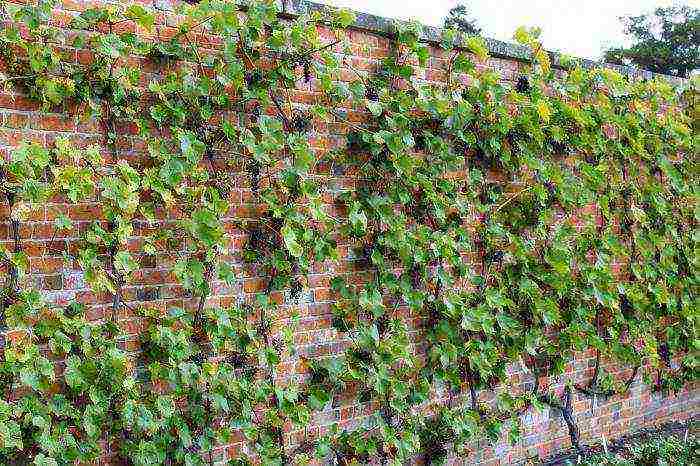
When planting young grapes, it should be borne in mind that the bush in this place will grow and bear fruit for many years, therefore, planting must be taken responsibly. Good drainage and nutritious soil must be laid in the planting hole. Broken brick is used as drainage. If the soil is heavy, sand should be added. Nutrient soil can consist of rotted manure or humus, to which 200-250 g of superphosphate must be added, this fertilizer is necessary for the future harvest.
If done correctly, young grape bushes begin to bear fruit in the 3rd year. Further care consists in the competent formation of the bush and pruning. In hot summers, grapes require watering about 5 times per season. Watering should be sparse but abundant.
To avoid freezing, even frost-resistant grape varieties in areas with cold winters must be covered.
The extreme climate of a sunny berry is not a hindrance. And getting a good harvest of grapes in the second or third year after planting is an achievable goal even for beginners.So, how to stop dreaming and start growing grapes ...
First, let's decide on the two most important tasks in growing grapes - we will choose a place for planting grapes and the varieties that we will plant. In principle, the vine will grow almost everywhere (except for a solid shade), and if you take care of it, at the very least it will bear fruit. However, competent planting in the right place will allow you to get really good yields with much less effort. Remember that planting seedlings of low-quality varieties in a vineyard will take your time, energy and good mood. You may be undeservedly disappointed in the grapes, although the mistake will be entirely yours.
Place for planting grapes
The vineyard should be sunny and sheltered from the wind, for example by the southern wall of a house, a barn or a south-facing fence with well-drained soil. If there is a minimum slope on the site, plant the grapes on a gentle southern or southwestern slope, orienting the row in the south-north direction. If the plot is flat and the southern walls are occupied, create a place for your grapes by building in any convenient place on the plot a nice solid fence 1.8–2 m high, oriented along the "east-west" line. And you will immediately understand the secret of the monastery vineyards! You can also use for this purpose dense hedges or screens from available materials, for example, from vines or reeds.
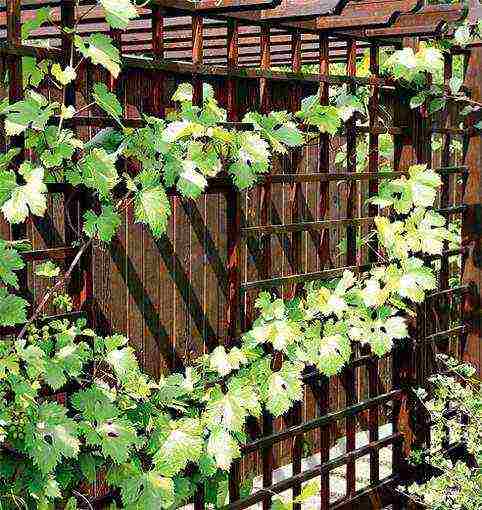
Tips for a new wine grower
-
The method of planting grapes depends on the type of soil. Variants are possible, but usually it is recommended to plant grapes on sandy soils in trenches, and on poorly heated loams and clays and in areas with a close occurrence of groundwater, it is recommended to plant on ridges, which in the old days were called "created".

For watering and feeding the grapes, I place plastic bottles with a cut-off bottom between the seedlings. For table varieties, as the bushes grow older, I replace them with asbestos-cement pipe trimmings, and for “techies” (wine varieties) I remove them altogether after three years. Mature wine grapes have to get their own water from the soil, and the deeper the roots, the better the wine from its berries.

-
Do not rush to plant seedlings "for permanent residence", especially if these varieties are on trial. Let them live until the first signal brushes in the school (where it is easier to cover). In the first year, some northerner growers do not plant seedlings in open ground at all, but keep them there in mobile containers (for example, in buckets), half buried in the ground. In autumn, containers with seedlings are moved to the basement, and in late spring they are planted. Such seedlings begin to bear fruit earlier.
-
Don't spontaneously plant vines. If your grapevine bushes are not in a "spot" planting, planning of the vineyard is necessary. Group varieties by purpose, as they have different planting intervals. The distance between bushes of varieties for juice and wine purposes is 0.8 m, for table varieties - at least 1.5 m, between rows - 2–2.5 m. It is advisable to clarify the strength of growth of the selected varieties in order to correctly calculate the right place. Grouping varieties by ripening and frost resistance will facilitate the care of the grapes. You will not need to spray and cover everything to the maximum.
-
Do not plant grafted seedlings (from European and southern nurseries) vertically, but place them practically lying at the maximum possible angle, otherwise there will be problems with the ripening of the vine. Gradually translate them into your own roots.
- Remember that grapes have the property of vertical polarity. When opening, tie a fruitful arrow on a trellis or stakes only horizontally - then all annual green shoots will grow equally. With a vertical garter, shoots grow intensively only from the upper eyes, and from the lower ones, they grow weakly or do not grow.
-
Limit watering. It is only obligatory to water young vines for the first 2 years and water-charging watering, which is common for all varieties, in the fall.Stop watering 7-10 days before the expected flowering, as excessive moisture causes the color to shed and delays the ripening of the crop.
-
Do not use sprinkling, otherwise you will provoke disease. Arrange drainage channels and place irrigation pipes on the side of the row spacing no closer than 30-50 cm to the base of the bush. Grapes do not like wet leaves and damp ground surfaces. If possible, arrange a visor over the grape bushes.
-
Conduct green operations sparingly and on time. Simultaneous removal of all growth points on the shoot is unacceptable: both chasing the top and pinching the stepsons. After all, there is a danger that the wintering buds of the bush will start to grow and its potential will drastically weaken. Do not break out stepchildren completely, leave 1-2 sheets. Carry out minting in August, immediately after straightening the crown.
-
Pruning the grapes is necessary, otherwise the berries are crushed, and the bush will grow unnecessarily. But in the year of planting, there is no pruning, except for the removal of unripe green parts of the shoots in the fall. From the 3rd year, prune the shoots according to the recommendations (short or long pruning), but do not mindlessly follow the recommended total load, since your conditions - relief, soil, the sum of active temperatures (CAT) - will correct it. Write down from which bud the fruiting shoots grow specifically for you.
Read more: Pruning grapes for beginners .
-
Do not carry out autumn pruning before natural leaves fall or night temperatures are below freezing (early November). Do not prune in the spring, as the "crying" of the vine (sap outflow) weakens the plant.
Read more: How to stop the crying vine>.
-
In the north, it is more reliable to use non-standard formations of a fan or semi-fan type, rather than high-standard ones, including for arbors.
Read more: Cordon formation and pruning of grapes.
Read more: Forming grapes for growing on a gazebo>.
-
Winter shelter for the first 2-3 years is needed for all seedlings. The first year the grapes grow tied to a temporary trellis. In autumn, shoots are removed and covered with a two-three-layer air-dry shelter. As a bedding - spruce branches or boards, on top of the seedlings - a layer of spunbond or corrugated cardboard and a film on top (roofing paper, old linoleum). Snow will complete the rest. Leave ventilation slots at the ends of the shelter.
-
Do not remove the cover immediately and completely in the spring. And when removed, leave a couple of layers of spunbond or lutrasil nearby in case of frost.
- Record the timing and characteristics of planting, flowering, ripening, pruning and loading of grapes in a diary. Otherwise, the most valuable information for the analysis of variety testing will be forgotten and lost. And you and the next generation of northern winegrowers, who will definitely come after you, need it so much.
How to grow grapes in the middle lane.
Winter hardy grape varieties
The most necessary requirements for grape varieties in the Moscow region and to the north are frost resistance, the ripening period of the crop and vines. But you shouldn't put so-called “non-concealment” at the forefront. This concept is relative and does not depend on the variety, but on what are the minimum temperatures in winter in your country house. In the first step, choose the earliest frost-resistant varieties. Later, with experience, an understanding will come that northern viticulture also provides us with certain bonuses, for example, in the form of long daylight hours, which partially compensates for the missing warmth of the grapes. And then you can try growing later varieties.
In addition, in the north, there are practically no diseases and pests of grapes. However, it is always better to prevent danger. There are so-called complex-resistant grape varieties - with high resistance to both frost and disease.
Read more about grape diseases and how to treat them.
Also determine the purpose of the grapes.Why do you need it: for the table, for juice and wine, for decorating the gazebo, or just "so that there was"? Today there are more than 15,000 grape varieties, so there is plenty to choose from.
For beginners, I would advise tasty and unpretentious table varieties ‘Agat Donskoy’, ‘Aleshenkin’, ‘Yubileiny Novgorod’, universal ‘Platovsky’, ‘Crystal’, ultra-early table ‘Krasa Nikopol’, as well as some universal Amur hybrids A.I. Potapenko and F.I. Shatilova. Those who have children should pay attention to the super-early and tender-sweet varieties ‘Liepaisky Yantar’ and ‘Early Tsiravsky’ (selected by G.E. Vesminsha), as well as the ‘Krasa Severa’ variety with a high content of useful folic acid. From the listed grape varieties, select no more than four to five for the first planting.
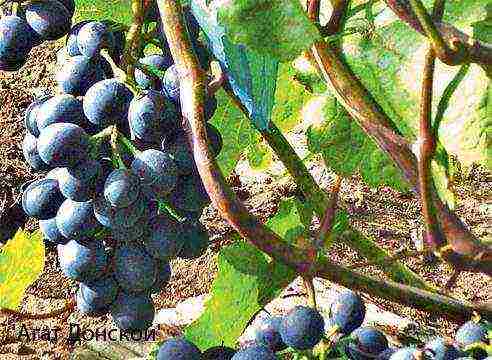


How to buy grape seedlings and rooting cuttings
The most reliable sources of planting material are winegrowers' clubs and forums, where enthusiastic and experienced gardeners and collectors communicate, as well as MOIP and TSKHA. You should not buy seedlings and cuttings at spontaneous roadside markets and exhibitions (of course, this does not apply to the stands of well-known nurseries).
How to buy grapes and choose a good seedling.
You can ask a question to the author of the article, wine grower Olena Nepomniachtchi, here .
You can find out how to grow other plants, what kind of gardening work you need to plan, from other articles on our website. Also, please pay attention to the information block to the left of the text. The links located in it lead to articles of related topics.
In the summer cottages of gardeners in the middle lane, unpretentious frost-resistant varieties are often found. These include, for example, "Lydia" or "Isabella". But, unfortunately, they differ in small berries and inexpressive taste. Thanks to the efforts of breeders, species have appeared that give large berries in the harsh climatic conditions of Russia.
Having bought varietal specimens of modern breeding, one can hope for a good harvest, resistance to disease and frost. By the way, the rich taste of a large beautiful bunch will not yield to overseas products. Growing grapes in the middle lane for beginners is recommended to start with early varieties. Their ripening occurs in mid-August. Such varieties are considered no less popular: Kesha, Arcadia, Muromets and Kosmos. All of them are distinguished by large, fleshy berries, the size of a small plum. They have a delicate aroma, sweetness and great taste.
When should you buy planting material?
To purchase quality vines, take advantage of the advice of experienced winegrowers. Don't rush to buy. If you decide to buy a seedling in the nursery, do not take the first one that comes across. Assess the situation, compare types, prices. It will be good if there is an opportunity to inspect adult specimens during fruiting.
Consider purchasing cuttings from a large vineyard. Agree with the owner about the excursion, ask about the variety of varieties. Try the bunch you like. And then ask to sell the cuttings from the selected grapes. So you are guaranteed to get the right variety, and in addition to it, valuable advice and parting words.
Autumn material is usually more hardy than spring material. If he endures the winter cold, then in the spring he quickly grows.
It is not recommended for beginners to immediately take on complex and expensive hybrid specimens. They often require increased attention, a certain knowledge base and experience.
Purchased seedlings should not be stored. They are recommended to be soaked in clean water and planted in the soil a day later.
Do not take varieties of "elite" grapes on the market from obsessive sellers. Otherwise, you risk buying a "pig in a poke".
Where is the best place to plant?
If you plan to plant one bush, try to find a sunny spot for it. It should be away from trees and bushes. For the future large vineyard, a place with the following characteristics is selected:
- slope from the south, southwest or east side;
- well lit space during the day;
- a place far from groundwater and marshy surfaces.
Do not plant the vine on the north side, under a tree, or near a body of water.
How to plant?
The material purchased and soaked during the day is slightly trimmed. The roots are shortened quite a bit, but the shoot is reduced by 3 buds. If there are side layers, they are also removed. The prepared seedling is dipped with roots in a clay solution, and placed in a prepared trench or pit.
Consult with experts on how to feed the grapes during planting, at what depth to place the heel of the shank and what drainage is best for your area. Such advice would be better than general advice.
If planting is carried out in winter, then a mound should be made around the sprout, and when cold weather comes, cover it with a plastic bottle. From above, the shelter can be covered with mulch or peat. Spring planting involves moistening the planting pit. Having planted the shanks and compacting the soil around them, they make shading. The bright spring sun can burn young shoots. A week later, spring seedlings are watered again, and after the soil dries out, its top layer is loosened.
How to care for a vineyard in spring?
After the start of growth of young specimens, as well as one-year-old and two-year-old seedlings, a number of mandatory procedures are required. Spring grape care is as follows:
- removing weeds under the vine and around the bush;
- loosening the topsoil;
- annual pruning of weak roots at a depth of 20 cm underground (the soil is raked off and pruned);
- spring preventive spraying of plants with Bordeaux liquid before the beginning of the growing season.
How to water properly?
To ensure sufficient nutrition for adult plants, you need to water abundantly several times during the spring and summer season. At a time - at least 15 liters of water under 1 bush. The water in the roots must not stagnate. Otherwise, fungal diseases and decay of the root system are possible. Properly organized drainage will help to avoid this. To understand how often to water grapes in summer, you need to know the temperature regime of the region in summer. In a cold and rainy summer, you can fill the bushes 2 times. If the temperature readings are normal, then you can spend 4 watering season.
If the weather is too humid, then the grapes should be given special attention. Special treatment of grapes after rain is required. High humidity provokes the immediate spread of harmful spores. It is necessary to spray the bushes with multipurpose solutions that can protect against late blight, mildew and powdery mildew.
What is pruning and when to do it?
Middle lane growers perform global pruning twice a year. Pruning grapes in the fall is necessary before sheltering for the winter. Long shoots are shortened, after which it is convenient to lay them in a depression and cover. The spring procedure takes place after opening. Frozen and dry shoots are removed. In addition, during the growth of the bush, the shoots are pinched and pruned for the correct formation of the vine.
In order for the bush to be properly formed, it must be pruned from the first year. Green shoots break off, preventing them from braiding branches. On young specimens, flowering branches are removed, preventing the berries from developing. First years can be exhausted, giving all their strength to growing a bunch. The shoots left behind are guided and tied up.
If you expect to get a powerful plant, then it is better to direct all the shoots left up.
The correct formation of a grape bush from the first year is shown in a video that will help you understand the basic principles of the procedure and prevent mistakes.
How to shelter grapes for the winter?
All hybrid varieties need warm wintering.Therefore, in the fall, before the onset of frost, it is necessary to dig in or cover all the shoots with a covering material. This will keep the plant from freezing. After the autumn pruning, the bush is well watered. Then all the lashes are removed from the trellises and laid on straw or dry leaves. From above, they are covered with spruce branches, a wooden structure, or simply covered with a layer of earth.

